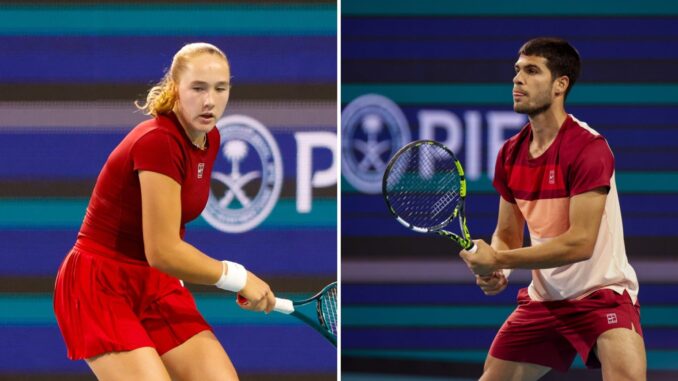
At just 17 years old, Mirra Andreeva is rewriting the tennis rulebook with a feat so astonishing that it’s left even seasoned pros in awe. Andrea Petkovic, the former world No. 9 turned insightful pundit, has heaped praise on the Russian teenager, calling her latest achievement “insane” and pointing out that it’s something even the prodigious Carlos Alcaraz couldn’t pull off at her age. As the 2025 season heats up, Andreeva’s meteoric rise is stealing headlines, and her latest milestone—a jaw-dropping display of dominance—has sparked comparisons to the sport’s brightest young stars, with Petkovic leading the chorus of admiration.
Andreeva’s breakthrough came at the Miami Open in late March 2025, where she stormed to the title without dropping a single service game across seven matches. That’s right—49 holds in a row, a statistic so staggering it’s hard to wrap your head around. “I’ve never seen anything like this from a 17-year-old,” Petkovic marveled, her voice tinged with disbelief as she unpacked the teenager’s run. For context, Alcaraz, the Spanish sensation with four Grand Slams by age 21, never managed such a feat at that tender age. His own ascent was meteoric—claiming the 2022 US Open at 19—but Andreeva’s serving clinic in Miami has set a new benchmark, one that’s got the tennis world buzzing.
Picture this: a wiry teenager with a steely gaze, stepping onto the hard courts of Miami and dismantling opponents with a serve that’s both a weapon and a fortress. She kicked off her campaign against American wildcard Claire Liu, then bulldozed through a murderer’s row—Liudmila Samsonova, Donna Vekic, Aryna Sabalenka in the quarters, Coco Gauff in the semis, and Elena Rybakina in a thrilling final. Each match, she held firm, her serve unbreachable even as the stakes soared. “Mirra’s serve is unreal—she’s holding against top players like it’s nothing,” Petkovic gushed, underscoring how Andreeva’s consistency under pressure outshines even Alcaraz’s early heroics. By the time she hoisted the trophy, ranked No. 8 in the world, she’d etched her name into the record books as the youngest Miami champion since Maria Sharapova in 2005.
What makes this “insane” run even wilder? Andreeva’s youth amplifies the improbability. Alcaraz was a phenom, sure—winning his first Masters 1000 at Miami in 2022 at 18—but he leaned on his athleticism and flair, not this kind of ironclad serving streak. Andreeva’s game, by contrast, blends precision with poise beyond her years. “She’s doing things at 17 that Carlos couldn’t do,” Petkovic noted, hinting at a maturity that’s rare in a sport where mental toughness often takes years to forge. Her Miami triumph wasn’t just about power; it was a masterclass in composure, with 26 aces and only 15 double faults across the tournament, stats that tell a story of control as much as dominance.
Andreeva’s ascent hasn’t been a fluke. She turned heads last year, reaching the French Open fourth round as a qualifier and cracking the top 20 by season’s end. But Miami was her coming-out party, a statement that she’s not just a future star—she’s here now. “It’s incredible to see her step up like this,” a fellow player remarked, echoing the sentiment rippling through locker rooms. Unlike Alcaraz, whose early career was marked by flashes of brilliance amid growing pains, Andreeva’s Miami run was a sustained symphony of excellence, her serve a metronome that never skipped a beat. Petkovic’s comparison isn’t about diminishing Alcaraz—it’s about spotlighting how Andreeva’s defying the timeline of tennis greatness.
As the clay season dawns, all eyes are on this Russian teenager. Can she carry this momentum to Roland Garros, where she’s already shown promise? Her Miami heroics have vaulted her into the top 10, a perch Alcaraz didn’t reach until after his first Slam. “She’s got the tools to keep shocking us,” Petkovic predicted, her words a rallying cry for a player who’s turning heads faster than anyone expected. For now, Andreeva stands alone, her “insane” achievement a testament to a talent that’s not just matching the best—it’s rewriting what’s possible at 17. And if Petkovic’s right, the tennis world hasn’t seen anything yet.
Leave a Reply